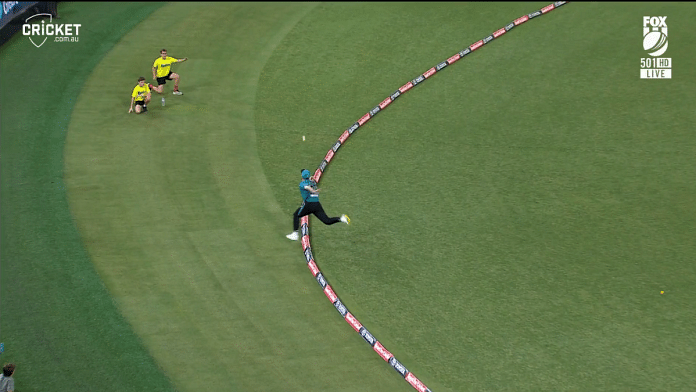New Delhi: Airborne boundary line catches that have given cricket some of its most memorable, thrilling and game-changing moments—fielders balancing, hopping, and exhibiting great presence of mind and skills on the edge of the boundary—has now been brought under tighter regulatory control. ‘Bunny hop’ catches have been outlawed.
The Marylebone Cricket Club (MCC), which governs the laws of cricket, has announced significant changes to the rules for boundaryline catches, aiming to bring greater clarity and fairness to the game.
The MCC has amended Law 19.5.2 which covers how catches near the boundary are judged. This change will take effect in international cricket from 17 June 2025 and will be officially included in the MCC’s Laws from October 2026.
The move is designed to end confusion and prevent fielders from using multiple touches of the ball outside the boundary rope, called ‘Bunny Hop’ catches by the MCC, while being airborne.
A fielder does so when he/she realises that after catching the ball inside, their momentum may carry them outside. To keep the ball in play, the fielder throws it up, hops outside the boundary, and then jumps back in to complete the catch or pass it to a teammate.
Also Read: Kohli, Rohit, Maxwell—as cricket legends bow out, 2025 becomes year of big retirements
What the new rule says
Under the new law, if a fielder jumps from outside the boundary, he/she can touch the ball only once while airborne. After that first touch, the fielder must land and stay completely inside the field of play until the ball is dead.
If the fielder lands or steps outside the boundary at any point after that first touch—even after completing the catch or a throw—it will count as a boundary.
This rule also applies to relay catches involving more than one fielder: every player involved must have last touched the ground inside the boundary before they touch the ball.
If a fielder throws or taps the ball back into play after jumping from outside, they must land and remain inside the field for the rest of the play, or else it’s a boundary.
In short, the fielder gets one chance to play the ball from beyond the rope.
After that, all further involvement must happen with both feet inside the field. If at any time during the delivery the fielder steps outside the boundary again, it will be signalled as a boundary, regardless of what happens to the ball.
This is fascinating.
Out? Six? What's your call? #BBL12 pic.twitter.com/v22rzdgfVz
— KFC Big Bash League (@BBL) January 1, 2023
The International Cricket Council (ICC) Cricket Committee requested the MCC to review the law and both bodies collaborated on the new version. An MCC note, circulated by the ICC to member boards, stated
“Our solution has been to limit any fielder who has gone outside the boundary to touching the ball while airborne only once, and then, having done so, to be wholly grounded within the boundary for the rest of the duration of that delivery. Even if the ball is parried—to another fielder or inside the field of play—if the fielder lands outside the boundary, or subsequently steps outside, then a boundary will be scored. For clarity, that means the fielder gets one chance, and one chance only, to touch the ball having jumped from outside the boundary. After that point, the boundary becomes a hard line—and any time they touch the ground in that delivery, whatever else happens, they must be inside.”
Catches in consideration
This rule change follows a series of catches that stirred debate across the cricketing world. The MCC reviewed a few of these incidents, with one particularly notable example involving Michael Neser during the 2023 Big Bash League.
In that match, Neser, representing the Brisbane Heat, chased down a lofted shot from Sydney Sixers’ Jordan Silk at wide long-off. After catching the ball with both hands, his momentum carried him over the boundary. Demonstrating a keen awareness of the boundary law, Neser tossed the ball up while still airborne, landed outside the rope, leapt again to palm the ball back into play with both feet off the ground, and then re-entered the field to complete the catch. Silk was given out, leaving the field visibly puzzled by the decision.
Another example comes from the 2020 Big Bash League, where Australian player Matt Renshaw completed a boundary catch by tapping the ball back in while being airborne outside the field, allowing his teammate Tom Banton to finish the dismissal.
While this play was legal then, it would now be ruled a boundary under the new MCC law.
This is genuinely blowing our mind. After all that, Matthew Wade is GONE!
What a @KFCAustralia Bucket Moment | #BBL09 pic.twitter.com/vT3BtmYGU8
— KFC Big Bash League (@BBL) January 9, 2020
The fairness of both catches was widely debated and there were strong calls to tweak the existing laws back then.
The MCC’s update aims to eliminate controversial boundary catches while still allowing for spectacular fielding efforts that begin within the field of play so long as it happens within the ‘boundaries’ of the game.
(Edited by Ajeet Tiwari)
Also Read: A batting blitz, ‘notebook’ & chaos. When Rathi-Abhishek on-field antics became IPL’s talking point






